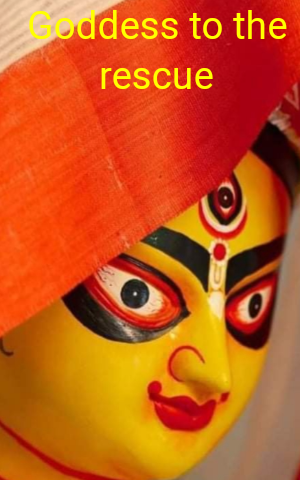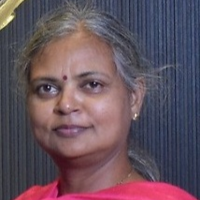Goddess To The Rescue
Goddess To The Rescue


The monsoon has begun to retreat. The sky is now deep blue with tufts of white cloud here and there floating with the slow wind blowing across. The wind pattern is changing. The autumnal equinox has passed.
We are now in autumn. This is the time for the festivals. Ganesh Utsav or festival for the Ganesh Puja is over allowing the festival season to begin Vishwakarma or the celestial engineer to whom is dedicated one day for worship is also gone by.
Now Goddess Durga will make her annual sojourn to her paternal home with her family of two daughters and two sons. Lakshmi and Saraswati are the daughters, Ganesh and Kartik are the sons.
The Bose family of Hooghly are busy making preparations for the Goddess welcoming. Their family has been hosting the autumnal religious festival for the last four generations. Countless more households in Bengal and elsewhere are getting ready for their Puja celebration. Now, this has become a social occasion where the full community takes part. Even people from other communities join in. The world over interest is created over the ten days of Durga Puja which now not confined to India only. The expatriates have taken this iconic festival to the foreign shores where it has taken a carnival look.
This time is the homecoming of all the sons and daughters to their native place from all over the world to join in the celebrations and to meet their loved ones. The Bose household is also gearing up to welcome their sons and daughters who are staying away for economic reasons. This time will be a reunion of all members of the family and extended family.
The patriarch of the family Rathin Bose is the organiser of the grand event. During the Chariot Festival or Rathyatra of Lord Jagannath in the months of June-July, the foundation is laid by way of 'Khuti Puja'. The sculptors then begin their work of building the images of Goddess Durga and her kids.
The images are built with clay, wood and bamboo. Nails are used to securing the wooden frame. The clay used for constructing the images is brought from the Ganges River. But as now due to scarcity most of the clay used is brought in from the local ponds and little from the Ganges as a ceremonial token. Then hot blowers are used to dry the images and sprinklers are used to spray the images with paint to colour them.
Just a fortnight before the celebrations the grand introduction of the festival time is done on a day called Mahalaya. This day is remembered as the victory of good over evil.
From mythology, we know that on the earth the demons were creating havoc. So much disturbance they were wreaking that the Gods in the heaven were getting jittery. So all the Gods went to Lord Brahma the creator of the world to help counter the menace of the demons. Brahma advised all the Gods to unite with their contributed strength. All the Gods obeyed Brahma and united their strengths together and from this union, a female form Durga was created, the symbol of force, Shakti.
This female form of Force, Durga then fought with the demons and their leader Mahishasur. The demon king hid in the belly of a buffalo that is Mahish that is why he is called Mahishasur. Goddess Durga fought and won and killed the demon with her trident.
This full story is enacted in a prose and song recital which was recorded by All India Radio under the recitation of Shri Birendra Krishna Bhadra. On the Mahalaya morning at 4 am all the radio stations play this recital which lasts for one and a half hours. This radio recital has also become symbolic for the past half a century as a welcome to the Durga Puja celebrations.
The Goddess Durga image has ten hands and on each hand is a weapon or instrument. The weapons symbolising various human virtues are as follows - conch, discus, lotus, sword, bow with an arrow, Trishul or trident, mace, thunderbolt, snake and finally a flame. After the image is made the weapons are fitted into the hands. In some part of the country, nine days of worship by the name Navratri is celebrated. The Goddess is worshipped on nine days in nine forms namely, Durga, Shailputri, Brahmacharini, Chandraghanta, Kushmanda, Skandmata, Katyayini, Kaalratri and Mahagouri.
As the Puja days are approaching the family members who are staying away start trickling in. The Bose household is also now full. All the members have arrived. The Puja days begin from the sixth day onwards when the main rituals start. The Goddess is given bhog or the food for the Gods every day. The bhog is then distributed among devotees as Prasad or God offerings. The bhog is made very deliciously and everybody enjoys eating it. On the tenth day that is Dashami, is the immersion. On this day the deity along with her family are ceremonially given a farewell. Before the farewell, the deity is smeared with vermilion and sweets are offered. Then all the ladies play amongst themselves by smearing each other with vermillion on their faces which is called 'sindur khela'. There is enjoyment everywhere but at the same time, there is sadness because the Goddess would leave and again the wait would begin for her homecoming next year.
During the puja days as there is merriment on one side while on the other there is some distress and anguish. Some section of the society are unable to participate in the mirth due to their social and financial condition. There is a report of theft and break-ins. People every year report of loss and missing items. The Police force is made alert in advance. Crime generally sees an upward curve.
Rathin Bose, the patriarch of the Bose household had made special security arrangements to counter the issue of burglary. After all, there is a lot of jewellery item around some on the images and some on the ladies of the House.
On the immersion day before the smearing of the deity with vermilion, the images are brought down from the stage. There beneath the Goddesses image was found a big bundle wrapped in bright red cloth.
Everyone was startled to see it. There was curiosity regarding its origin and ownership. Then the bundle was opened and it revealed a huge pile of jewellery of various shapes and sizes and of different makes. Then began a lot of commotion of how to deal with it. People suggested reporting the matter to the Police.
But Rathin Bose suggested that the Village Panchayat to be called to decide on the fate of this jewellery. The Panchayat welcomed this decision. They said that if Police is brought in then they would confiscate all of it. This jewellery belonged to the village and somehow this was the work of one thief or some thieves. These thieves probably couldn't take away this loot and have kept it hidden under the deity's image to be retrieved later on. But they had failed to claim them somehow.
The panchayat organised an open house session with the participation of all the villagers to decide the fate of the jewellery. The villagers unanimously decided to use the jewellery for the benefit of the village. It was decided to monetise half of the lot and keep it as a Fixed Deposit in the Cooperative Bank in the village. The remaining half to be kept in the vault of the Bank as security which would be managed by the Panchayat executive body. Because gold has an appreciating value and could be used as a cushion for the future. The interest from the fixed deposit could be used for the well being of the villagers in times of natural calamities and epidemics.
Everyone was unanimous with this decision that it was an act of divine intervention and definitely the Goddess had rescued it from the thugs.
































































